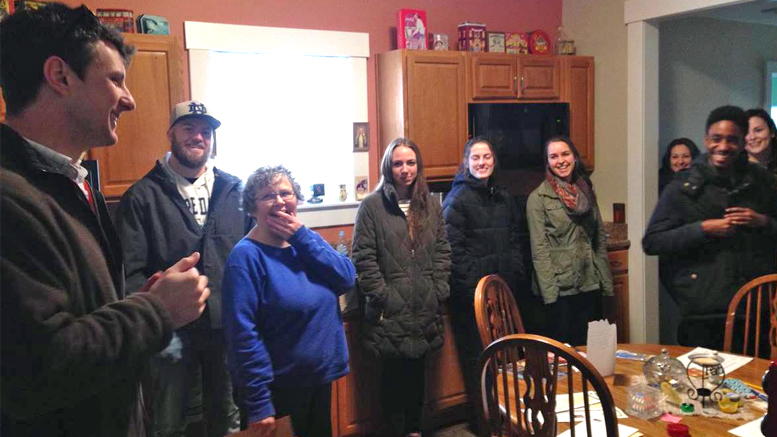By: Shannon Greeley—
Retired school teacher Norma Ruttan thought she might never leave her mobile home. But in January, the Muncie native moved into her “dream house” doors down from her son in the Thomas Park/Avondale neighborhood.
Her inviting, energy-efficient home had been a vacant, dangerous eyesore. In January 2014, the city condemned the 10th Street property after its owner was arrested for allegedly cooking methamphetamines. Vapors from production of the synthetic stimulant lingered in its air vents, saturated the walls, and settled in the carpet. Neighbors were convinced the house was destined to become one of Muncie’s nearly 150 former meth homes turned abandoned, weed-ridden lots that leave a lasting scar.
Enter ecoREHAB, a Muncie non-profit driven to advance community through the promotion and practice of sustainable design, building, and education. Craig Graybeal, the organization’s executive director, purchased the home in 2015. He laid the groundwork for 23 Ball State architecture students, led by Professor Jonathan Spodek, to transform the deteriorating property into a safe, affordable home during spring 2016. Only one piece of its past remains: a single bathroom window.
“Meth homes are not destined to become toxic wastelands” said Graybeal, twice a graduate of Ball State’s College of Architecture and Planning. “With expertise and care, they can be cleaned and be given new life, and that’s what you’ve got here. 1215 could have been yet another abandoned lot—creating holes in the urban fabric of our city. Instead, with the guidance of the Delaware County Health Department, we were able to decontaminate the house and provide Norma with a safe, efficient home.”

Ball State Journalism Instructor Kate Elliott is guiding a team of marketing, public relations, and advertising students to help ecoREHAB tell its compelling story. The students met with ecoREHAB’s latest homeowner, Norma Ruttan, at her home on 10th Street. Photo provided.
Rehab inspires hope, dispels myths
Neighbors are thrilled this once darkened door is a source of light and hope for the community. Jacqueline Hanoman is executive director of the Ross Community Center, which is down the street from Ruttan’s home. Hanoman said the rehab has given the neighborhood a second chance.
“Rehabbing a meth house improves the home itself, and it helps the community heal,” she said. “Organizations like ecoREHAB are vital to our community because they help people to recover their dignity that is so hammered down by the difficulties of daily life. It’s encouraging to know former meth homes can be safely renovated.”
“Meth carries a stigma, a horrible stigma of poverty, a stigma of an addict, a stigma of a life going to waste. However, in the eyes of the meth user, it’s something they do to escape reality. It’s cheap, and making meth makes money,” she said. “Neighborhoods don’t decline overnight, and we’re not going to bring them back overnight.”
Efforts fuel citywide revitalization
ecoREHAB understands this more than most. Since its inception in 2009, the organization has collaborated with Ball State architecture students to rehabilitate six homes in Muncie’s urban core neighborhoods, supporting citywide reinvestment efforts to address the more than 1,000 vacant buildings.
“If we neglect these houses, they’ll be torn down or worse—they attract rodents and crime, they’re fire hazards, and invite crime and squatting—detracting people from moving into the neighborhood,” Graybeal said. “The most efficient, best home is one that is already built. We need to continue to restore the existing homes within our community.”
In that spirit, ecoREHAB purchased 1211 W. 10th Street with a grant from the Community Foundation of Muncie & Delaware County. Graybeal said the organization plans to combine proceeds from the sale of 1211 W. 10th Street with proceeds from the sale of 1215 W. 10th Street to purchase the organization’s next, unknown, rehab location.
“Though I don’t know 99 percent of the thousands of people who also call Muncie ‘home,’ we are all neighbors, and we interact, one way or another, with each other,” he said. “Perhaps in 10 years we’ll see the fruits of our labors. In the meantime, it’s important for us to stay motivated, demonstrate our impact, and earn the support of Muncie.”
A recent survey of Muncie’s blight revealed that 62 percent of Muncie residents live within 300 feet of an abandoned property. Brad King, Muncie’s historic preservation officer, said given the city’s capacity to demolish 20 properties each year, it would take 105 years to address the existing vacant properties. That statistic, he said, reiterates the fact that the problem is everyone’s concern, and it will take the entire community to address.
“We engaged in a data-driven revitalization effort—ScoutMuncie—to gather information about property conditions, occupancy rates, and potential historic structures,” King said. “The comprehensive assessment is guiding community planning, fueling grant applications, and more.”‘
Our light must shine out the darkness
Hearing all of this, Ruttan said she has a newfound pride in her hometown, and in Muncie’s ability to pull together to make the city a better place for future generations.
“I’m so happy, living in my dream home and to be part of the good that can come out of something so terrible,” she said. “My neighbors have seen this investment, and it has encouraged us all to be the change in our community, and to create a sense of belonging. Our light must shine out the darkness.”
Learn more about ecoREHAB’s rehabilitation efforts at ecorehab.org, which also details its collaborations with community organizations to, for instance, repair the homes of elderly residents and offer design guidance to future builders. To promote sustainability, the organization offers low-cost consultation to homeowners and businesses eager to increase energy efficiency.
ecoREHAB Community Partners include:
The Ball Brothers Foundation, The Community Foundation of Muncie and Delaware County, Muncie Community Development, Ball State University, Solar Uniting Neighbors, and Pathstone Housing Corporation of America.



